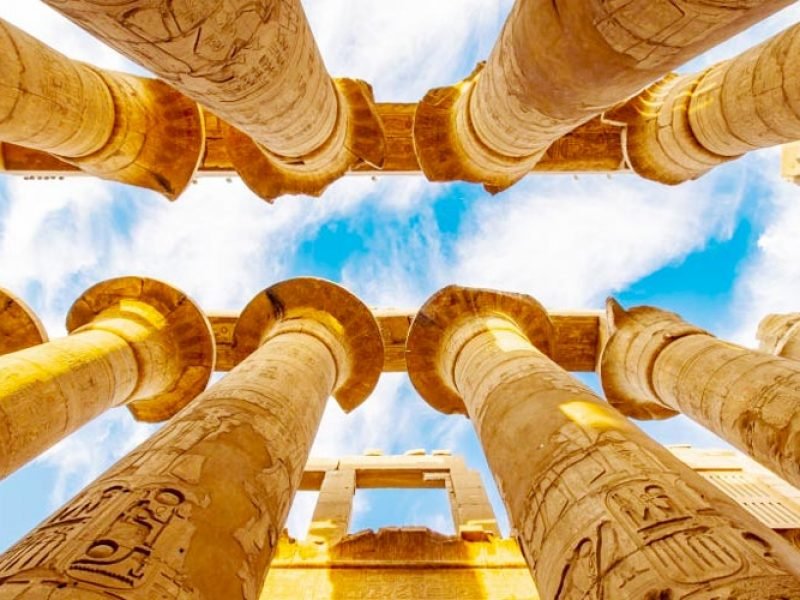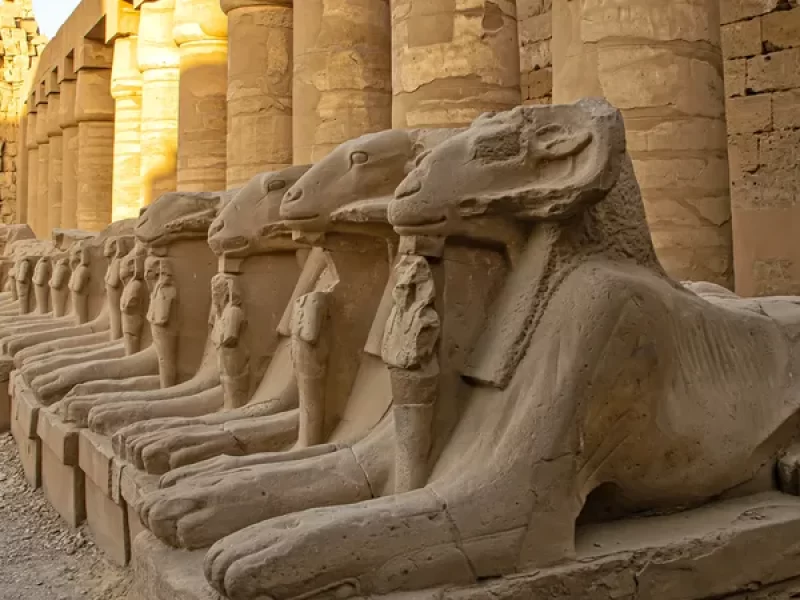The Karnak temple is situated in Karnak, Luxor Governorate, Egypt’s south, on the east bank of the Nile River.
The Karnak Temple was constructed between 2055 BC and 100 AD. It was built as a cult temple dedicated to the gods Amun, Mut, and Khonsu. The Karnak Temple has considered the “most select of locations” by ancient Egyptians since it was the largest sacred structure ever built.
Amun was the Egyptian god of the sun and air, also known as Amon, Ammon, and Amen. Amun is the ancient Egyptian civilization from the commencement of the establishment of the New Kingdom from 1570 to 1069 BCE and is considered one of the most important gods. Mut was an ancient Egyptian deity known as Maut and Mout. Her name means mother. Hence she was known as the mother goddess. For some, she was known as the mother of the universe, while for others, she was known as the mother of the moon child god khonsu. Khonsu, the ancient Egyptian god of the Moon, was the son of goddess Mut. ‘Traveler’ is the meaning of his name.
The Importance of the Karnak Temple
The Karnak Temple Complex was the focus of ancient faith during the New Kingdom when power was concentrated at Thebes (modern-day Luxor). Its prominence is reflected in its massive dimensions.
The Karnak Temple Complex was the focus of ancient faith during the New Kingdom when power was concentrated at Thebes (modern-day Luxor). Its prominence is reflected in its massive dimensions. It served as a treasury, administrative headquarters, and palace for the New Kingdom pharaohs and its religious significance. It is still regarded as the largest temple complex ever built anywhere. It grew over 1500 years, with pharaohs adding to it generation after generation, culminating in an unrivaled collection of temples, sanctuaries, towers, and other decorations throughout Egypt. While it was at its peak during the New Kingdom, when pharaohs like Hatshepsut, Tuthmose III, Seti I, and Ramesses II all added substantial improvements to the complex, development continued throughout the Greco-Roman Period, with the Ptolemies, Romans, and early Christians all leaving their imprint.
Visiting the Karnak Temple Complex
The precincts of Amun, Mut, and Montu are the three compounds that makeup Karnak; nevertheless, for most tourists, the greatest of these, the precinct of Amun, is sufficient. Its intricate layout alone eclipses everything else you’ll see in Egypt.
All of the most famous elements of the Karnak complex, notably the towering Great Hypostyle Hall, are located within the Amun precinct. This vast hall with 134 gigantic columns is one of Egypt’s most magnificent sights. Instead, we recommend that you set aside plenty of time to explore this massive complex and take in its many amazing views. Imagine how awe-inspiring these massive constructions must have been when they were first built over 2000, thousand years ago.
Book your deal now at www.kaytrips.com for Karnak Temple Complex – Luxor – Egypt
Like all of Egypt’s famous attractions, Karnak features a music and light display performed in several languages. The act is performed three times per night. However, the wording of the various showings should be confirmed with your tour guide or hotel.
Interesting Facts about the Karnak Temple
- In Karnak, almost 80,000 servants and enslaved people were sent to serve Amon-Ra, demonstrating his authority and prominence in the period. Five thousand monuments were also erected in his honor.
- Karnak is the world’s largest ancient religious site and an open-air museum. It is one of Egypt’s most popular tourist destinations.
- Giant pillars, towering columns, massive sphinx avenues, and an obelisk that measures 97 feet tall and weighs 323 tons make up Karnak.
- The Great Hypostyle Hall, at 54,000 square feet, is large enough to accommodate the Cathedral of Notre Dame.
- Karnak was built by a staggering 30-pharaohs, including Queen Hatshepsut, who was known for her craziness.
- What if I told you that surgical devices used in modern medicine aren’t all that advanced? Scalpels, forceps, prescriptions, birthing chairs, and medicinal bottles from Roman Egypt in Kom Ombo, one of Karnak’s temples.
- Kom Ombo was explicitly erected for the gods Sobek and Horus. The temple’s sanctuaries, halls, and apartments appear to be dedicated to the two gods.
Geese, rams, and about 421,000 head of cattle were kept in the temples of Karnak as Amon’s sacred animals.
After the Pyramids of Giza, Karnak is Egypt’s second most visited site. If you’re planning a trip to Egypt, include Karnak in your itinerary because your trip will be incomplete without it.
Book your deal now at www.kaytrips.com for Karnak Temple Complex – Luxor – Egypt
8. It was considered to be a very sacred place in Ancient Egypt
While the Ancient Egyptians called Thebes “Waset,” the Karnak Temple complex had a separate name that underscored its significance.
“It-is,” which means “The Most Selected of Places,” was the name of the complex.
9. It’s vast, and construction on the site happened for nearly 2,000 years
Because this location was considered one of the most sacred places by the Ancient Egyptians, almost every king of the 18th dynasty contributed to it.
Construction on the site is thought to have begun between 2000 and 1700 B.C. and continued until the Ptolemaic Dynasty, between 305 and 30 B.C. Over 30 pharaohs are thought to have contributed to the construction of the Karnak Temple Complex. This has culminated in constructing one of the most significant Ancient Egyptian structures ever, spanning over 250,000 square meters (2.69 million square feet).
10. The complex consists of a vast number of buildings and monuments
The complex is organized into four distinct areas:
- Precinct of Amun-Ra
- Precinct of Mut
- Precinct of Montu
- Temple of Amenhotep IV
11. One of its most impressive features was built during the 19th Dynasty
12. Some of the beams on top of the columns weigh up to 70 tons
13. Materials for the Precinct of Amun-Re were transported over a considerable distance.
The fact that these gigantic columns and granite blocks were brought from a quarry 160 kilometers (100 miles) away adds to the wonder of this achievement.
14. The sun god’s shrine was in the spotlight during the winter solstice
15. The 18th dynasty was the most prolific for the Karnak Temple Complex.
There were just a few minor temples and shrines where the vast complex was built before the 18th Dynasty, which ruled between 1550 and 1292 B.C.
16. The tallest ancient obelisk in the world broke during construction.
Hatshepsut, a woman who built one of the most spectacular temples in Ancient Egypt and was named after her, was one of the most prolific pharaohs during the golden days of Karnak. Her most significant accomplishment was the renovation of the Precinct of Mut, dedicated to Egypt’s old great goddess. The complex’s entrance used to be adorned with two gigantic obelisks that, when completed, were the world’s highest.

Book your deal now at www.kaytrips.com for Karnak Temple Complex – Luxor – Egypt
17. In 1997, Hatshepsut’s chapel was restored with genuine materials.
Another construction by Pharaoh Hatshepsut was a shrine known as the “Red Chapel,” built between 1479 and 1458 B.C. It was destroyed in antiquity, and its exact position is still a point of contention. Some say it was in the center of the Temple of Amun, while others say it was precisely between Hatshepsut’s two massive obelisks.
One of the most incredible Karnak Temple facts is that the Red Chapel’s original building materials were uncovered in the late twentieth century, and the shrine was reconstructed in 1997.
18. Some of the buildings were turned into Christian churches in the 4th century.
In the year 30 B.C., Ancient Egypt became a province of the Roman Empire. Some of the constructions were converted into Roman temples. More notably, in the fourth century, the Roman Emperors, beginning with Constantine the Great, converted to Christianity, restoring some old monuments into Christian churches. Saints images going back to the reign of Constantius II in the year 356 A.D. can still be seen in one of the temples, the Festival Hall of Thutmose III!
19. Europeans didn’t discover Karnak until the late 16th century.
Even though many Roman authors had made distinct references to the Karnak Temple Complex, some as early as the 2nd century, such as Claudius Ptolemaeus’ work “Geographia,” a detailed account was not published until the late 16th century.

Book your deal now at www.kaytrips.com for Karnak Temple Complex – Luxor – Egypt
20. It’s one of the most popular tourist attractions in Egypt.
Amun-Re’s precinct is available to the public; even though the temple has four central portions, only the main and most significant is open to the public. Because these are important archaeological sites, the other areas are inaccessible to the general public.
21. The temple has appeared in several films.
The Karnak Temple Complex and its ancient monuments have been included in several video games, literature, and films.
The following are a few of the most notable:
- Transformers: Revenge of the Fallen (2009)
- The Mummy Returns (2001)
- The Spy Who Loved Me (1977)
Book your deal now at www.kaytrips.com for Karnak Temple Complex – Luxor – Egypt


Comment (0)